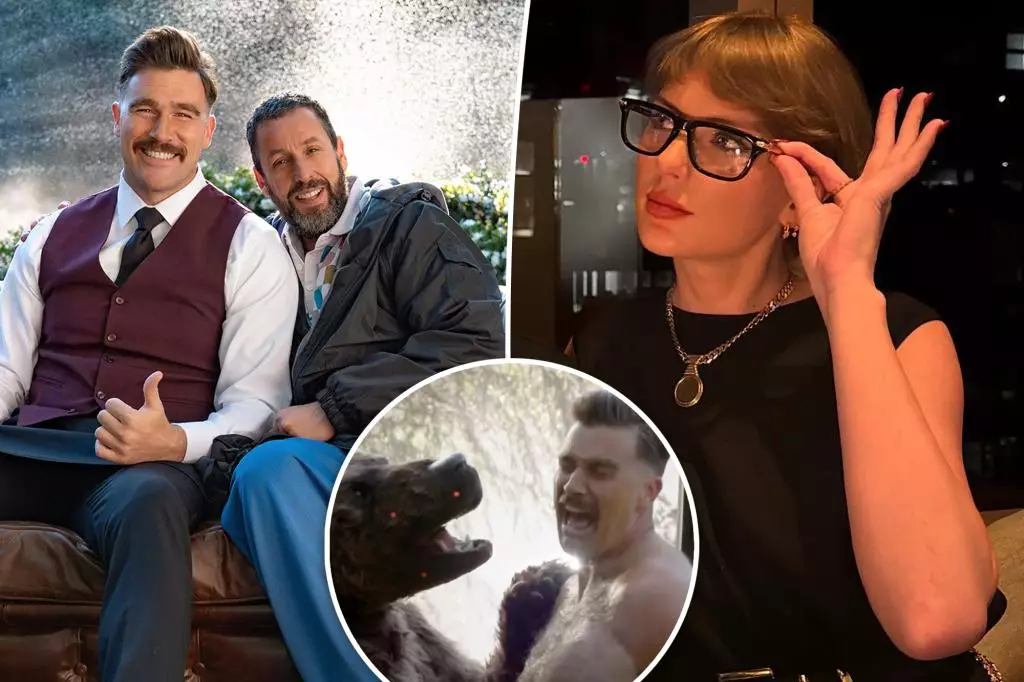The internet has a remarkable talent for conjuring speculation that captures the collective imagination of fans worldwide. Recently, a playful yet compelling theory has taken hold: that Taylor Swift, the global pop phenomenon, made a covert cameo in the recent comedy sequel “Happy Gilmore 2,” alongside her boyfriend, NFL star Travis Kelce. This idea emerged amid a flurry of social media activity, fueled by behind-the-scenes glimpses, candid fan observations, and the undeniable star-power aura that both Swift and Kelce exude. The theory taps into fans’ desire for interconnected universes—where their favorite celebrities seamlessly blend into each other’s worlds—creating a sense of an intricate, secret world behind the Hollywood curtain.
At the core of this speculation is a Netflix behind-the-scenes video that features Kelce getting prepped for a scene where Bad Bunny’s character is attacked by a bear in a fantasy sequence. Fans noted the peculiar detail: Kelce’s character is portrayed as a villainous boss who, in a surreal twist, is eaten by the bear. The whispers among fans are that the bear in question might be none other than Taylor Swift in costume, cleverly camouflaged within the scene. Many took to social media with suggestions such as “They should’ve dressed Taylor as a bear for an epic surprise,” or questions like “Who is the bear?” with a wagging emoji, hinting at the possibility that Hollywood’s secret might have been accidentally or intentionally revealed through these snippets.
Moreover, Netflix’s playful engagement with fans—replying with an eyes emoji—heightens the playful intrigue, as if teasing a hidden Easter egg embedded in their content. The enthusiasm is contagious; fans eagerly dissect every frame and comment, fueling a narrative that combines star-studded glitz with internet detective work. It’s an intriguing convergence of celebrity culture, fan speculation, and the social media age’s obsession with decoding every detail.
The Power of Celebrity and Fan Engagement
Swift’s significant influence on pop culture is undeniable, and her active social media presence continues to amplify her connection with fans. Her recent Instagram Story promoting “Happy Gilmore 2” with a glowing endorsement and a playful honey emoji—likely referencing Kelce’s comedic honey scene—adds a layer of authenticity and genuine support. This endorsement injects credibility into the fan theories, making the idea of her cameo seem not just plausible but almost inevitable in the eyes of her followers.
Additionally, the relationship between Swift and Kelce has become a spectacle of its own. Their public displays of affection, social media confirmation, and Kelce’s own foray into acting all contribute to an environment where fans instinctively look for ways these worlds intersect. Swift’s support for Kelce’s acting pursuits reflects a broader trend—celebrity couples often work together or appear in each other’s projects, intentionally or not. Yet, her playful promotion of the film and fans’ interpretations of her commentaries add a sense of personal involvement—almost as if they believe Swift might be orchestrating something more than just a cameo; perhaps a shared universe where she subtly participates in Kelce’s Hollywood adventures.
Sandler’s praise for Swift—calling her “incredible” and noting her kindness—further deepens the narrative, creating a persona of a genuine, warm-hearted superstar who’s in on the fun without demanding the spotlight. His acknowledgment hints that, behind the scenes, there are genuine connections and warm relationships among these celebrities, fueling the speculation even further.
The Cultural Implication of Surprise Crossovers
The idea of Taylor Swift making a secret cameo taps into a tantalizing cultural narrative—a star hiding in plain sight, revealing herself only through subtle hints and clever clues. Such theories challenge the traditional boundaries of celebrity appearances, suggesting an almost conspiratorial universe where stars enjoy playful privacy and fans revel in decoding cryptic signals. It reflects a cultural shift wherein celebrities no longer operate solely through scripted interviews or major premieres but instead embed themselves in everyday content, inviting fans to become part of the story.
This phenomenon also underscores the hunger for authenticity and “insider” knowledge in the digital age. In a world inundated with flashy publicity and curated personas, fans crave genuine surprises—moments of real connection that feel like secret gifts from the stars. Whether or not Swift’s cameo is real, the fervor it has ignited demonstrates how strongly the public craves moments of mystery, especially involving beloved icons like her.
While skepticism remains justified—since many of these rumors are fueled by speculation rather than concrete evidence—their sheer popularity reveals something profound about modern fandom. Fans don’t just consume celebrity content—they seek to participate actively in deciphering it, turning every snippet, behind-the-scenes shot, or comment into a potential clue. This phenomenon illustrates a new era of celebrity engagement—one powered by fans’ relentless curiosity and the seamless merging of reality with the fantasy of stardom.
Ultimately, whether Taylor Swift truly made her secret appearance in “Happy Gilmore 2” or not, the excitement it has generated shows just how influential her presence remains in shaping pop culture conversations. It exemplifies the magic of celebrity in the digital age—not just as entertainment but as an ongoing, interactive spectacle where imagination often surpasses reality.

Leave a Reply